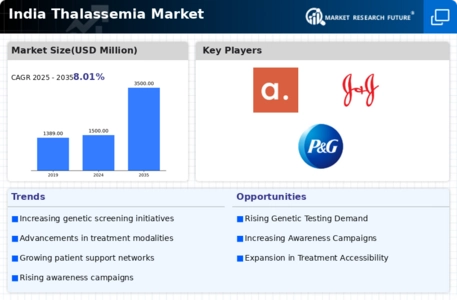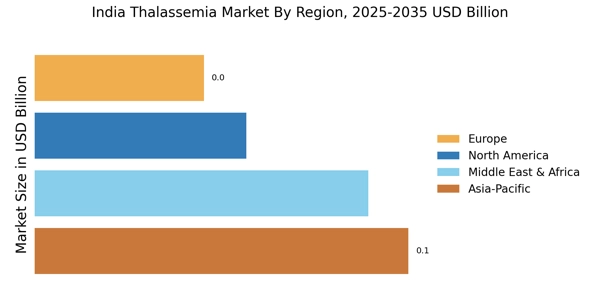Rising Prevalence of Thalassemia
The increasing prevalence of thalassemia in India is a critical driver for the India Thalassemia Market. It is estimated that approximately 10,000 to 15,000 children are born with thalassemia each year in the country. This alarming statistic highlights the urgent need for effective treatment and management options. The growing number of patients necessitates enhanced healthcare services, including blood transfusions and chelation therapy, which are essential components of thalassemia management. As awareness of the disease spreads, more families are seeking genetic counseling and screening, further propelling the demand for thalassemia-related healthcare services. Consequently, the India Thalassemia Market is likely to experience significant growth as healthcare providers adapt to meet the needs of this expanding patient population.
Government Initiatives and Policies
Government initiatives aimed at combating thalassemia are pivotal in shaping the India Thalassemia Market. The Indian government has implemented various policies to promote awareness, screening, and treatment of thalassemia. Programs such as the National Health Mission focus on early detection and management of genetic disorders, including thalassemia. These initiatives often include subsidized treatment options and public health campaigns to educate communities about the disease. Furthermore, the establishment of specialized thalassemia treatment centers across the country enhances access to care for affected individuals. As these government efforts continue to evolve, they are expected to bolster the India Thalassemia Market by increasing patient access to necessary healthcare services and improving overall outcomes.
Technological Advancements in Treatment
Technological advancements in treatment modalities are transforming the landscape of the India Thalassemia Market. Innovations such as gene therapy and improved blood transfusion techniques are emerging as potential game-changers in the management of thalassemia. For instance, recent developments in gene editing technologies, like CRISPR, hold promise for curative approaches to thalassemia, potentially reducing the lifelong dependency on blood transfusions. Additionally, advancements in diagnostic tools enable earlier detection and more personalized treatment plans for patients. As these technologies become more accessible, they are likely to enhance the quality of care and improve patient outcomes, thereby driving growth in the India Thalassemia Market.
Rising Awareness and Education Campaigns
Rising awareness and education campaigns play a vital role in shaping the India Thalassemia Market. Various non-governmental organizations and healthcare providers are actively engaged in initiatives to educate the public about thalassemia, its genetic implications, and the importance of screening. These campaigns aim to reduce stigma and encourage families to seek genetic counseling and testing, which is essential for early diagnosis and management. As awareness increases, more individuals are likely to participate in screening programs, leading to earlier detection and better management of the disease. This heightened awareness is expected to drive demand for thalassemia-related healthcare services, thereby positively impacting the India Thalassemia Market.
Increased Investment in Healthcare Infrastructure
The surge in investment in healthcare infrastructure is a significant driver for the India Thalassemia Market. With the government and private sector focusing on expanding healthcare facilities, there is a growing emphasis on specialized centers for thalassemia treatment. This investment includes the establishment of comprehensive care units that provide multidisciplinary support, including psychological counseling and nutritional guidance. Furthermore, the enhancement of blood banks and transfusion services is crucial for managing thalassemia effectively. As healthcare infrastructure improves, it is anticipated that more patients will receive timely and adequate care, thus fostering growth in the India Thalassemia Market.


















Leave a Comment